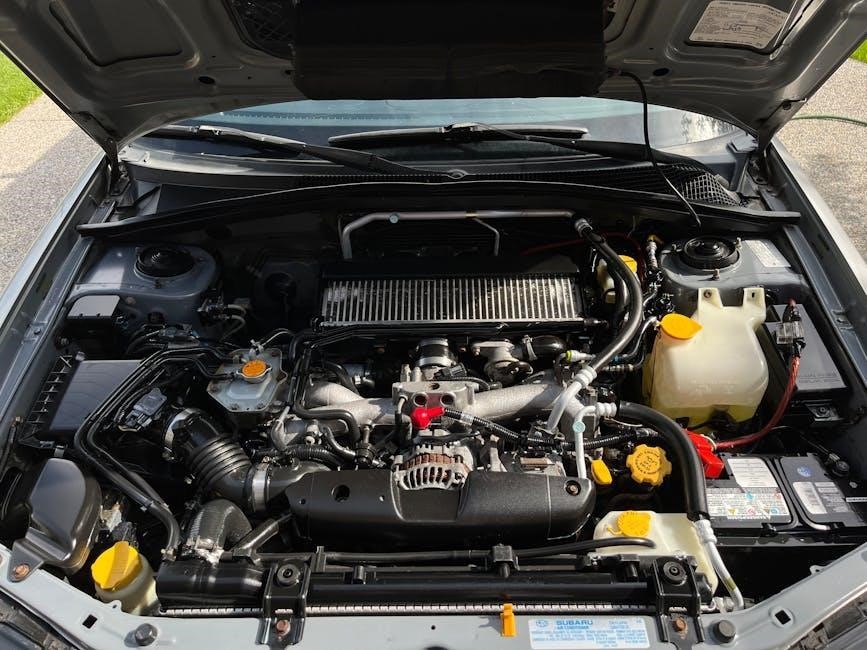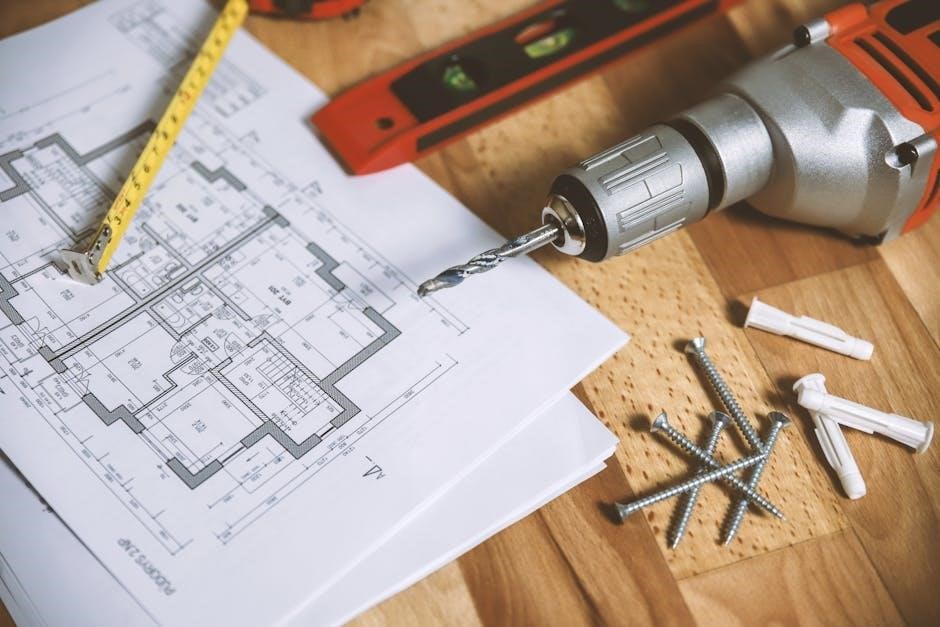
Honeywell Thermostat Wiring Diagram PDF: An Overview
This comprehensive guide delves into Honeywell thermostat wiring diagrams, offering PDF resources for seamless HVAC system management.
From basic setups to advanced configurations, users can find diagrams to suit their specific Honeywell thermostat model.
Understanding Honeywell Thermostat Basics
Before diving into wiring diagrams, it’s crucial to grasp the fundamentals of Honeywell thermostats. These devices regulate heating, ventilation, and air conditioning (HVAC) systems in residential and commercial settings. Understanding how a thermostat communicates with the HVAC unit is key. Thermostats monitor room temperature and signal the HVAC system to turn on or off to maintain the desired temperature. Knowing the difference between programmable and non-programmable thermostats is also important. Programmable thermostats allow users to set schedules for temperature adjustments throughout the day, optimizing energy efficiency. Furthermore, familiarizing yourself with the various components of a Honeywell thermostat, such as the display, buttons, and terminals, will aid in the wiring process. This foundational knowledge is essential for successfully interpreting wiring diagrams and ensuring proper installation.
Identifying Your Honeywell Thermostat Model
Accurately identifying your Honeywell thermostat model is paramount before consulting any wiring diagram. Each model possesses a unique wiring configuration, and using the wrong diagram can lead to improper installation or damage to your HVAC system. Typically, the model number is located on the thermostat itself, either on the back, side, or behind the faceplate. Look for a series of numbers and letters, such as “TH6320WF2003” or “RTH6580WF.” Once you’ve located the model number, note it down carefully. You can then use this information to search online for the specific Honeywell thermostat wiring diagram PDF that corresponds to your model. Honeywell’s website or other HVAC resources often provide these diagrams for free download. Ensure the diagram matches your model number exactly to guarantee correct wiring. Neglecting this step can result in system malfunctions or even safety hazards.

Decoding Honeywell Thermostat Wiring Diagrams
Understanding Honeywell thermostat wiring diagrams is essential for correct installation and troubleshooting. This section simplifies the process, focusing on common terminals and diagram interpretation for HVAC systems.
Common Terminal Designations (R, W, Y, G, C)
Navigating Honeywell thermostat wiring starts with understanding common terminal designations. “R” typically represents power, often from a 24VAC transformer. “W” controls the heating system, activating the furnace or heat source. “Y” manages the cooling system, engaging the air conditioner. “G” operates the fan, allowing for continuous airflow or fan-only mode.
The “C” terminal, often blue, is the common wire, providing a stable power connection. Alternate wirings are possible if labeled wires do not match terminals, but avoid using “C”, “C1”, or “X” wires in such cases.
Some systems have multiple fan speeds, indicated by G1, G2, and G3 terminals, but many retail thermostats may not be compatible with these complex setups. Correctly identifying and connecting these terminals is crucial for proper thermostat function and HVAC system performance.
Reading and Interpreting Wiring Diagrams
Successfully using a Honeywell thermostat wiring diagram PDF hinges on the ability to accurately read and interpret the information presented. Wiring diagrams are visual representations of how the thermostat connects to the HVAC system components. These diagrams use symbols and lines to denote wires, terminals, and connections.
Each terminal on the thermostat is labeled with a specific letter, such as R, W, Y, G, and C, each corresponding to a particular function. The diagram illustrates which wires from your HVAC system should be connected to each of these terminals. Understanding the color-coding of wires, though not always consistent, can also aid in correct identification.
Pay close attention to any notes or instructions included in the diagram, as they often provide crucial details about specific wiring scenarios or system configurations.

Step-by-Step Guide to Wiring a Honeywell Thermostat
This section provides a detailed, step-by-step guide to wiring your Honeywell thermostat. It emphasizes safety precautions and ensures correct wire connections to the appropriate terminals for optimal performance.
Safety Precautions Before Wiring
Before commencing any wiring work on your Honeywell thermostat, prioritizing safety is paramount. Begin by disconnecting the power supply to your HVAC system at the circuit breaker to prevent electrical shock. Verify the power is off using a non-contact voltage tester on the wires you’ll be working with.
Always consult the Honeywell thermostat wiring diagram PDF specific to your model to ensure accurate and safe connections. Wear appropriate safety gear, including insulated gloves and eye protection, to further minimize risks. If you’re uncomfortable working with electrical wiring, it’s best to seek assistance from a qualified HVAC technician.
Double-check all connections after wiring, ensuring they are secure and properly insulated. Never attempt to bypass safety features or tamper with components. These precautions are crucial for preventing accidents and ensuring the safe and effective operation of your Honeywell thermostat.
Connecting Wires to the Correct Terminals
Accurate wiring is crucial for proper Honeywell thermostat operation. Begin by carefully identifying each wire based on its label or previous connection. Consult your Honeywell thermostat wiring diagram PDF to match each wire to its corresponding terminal on the new thermostat. Common terminals include R, W, Y, G, and C.
Ensure each wire is securely connected to the correct terminal, tightening screws firmly but without overtightening. If a wire label doesn’t match any terminal, refer to the “Alternate Wiring” section of your diagram, but avoid using C, C1, or X wires if instructed.
For older thermostats with only one C or C1 wire, connect it to the C terminal. If there are two C or C1 wires, wrap each separately with electrical tape and do not connect them. This proper wiring ensures the thermostat functions as designed, maintaining optimal comfort and energy efficiency.

Troubleshooting Common Wiring Issues
Wiring issues can cause thermostat malfunctions. Addressing incorrect wiring symptoms early is crucial. Using a multimeter allows for effective diagnostics, pinpointing problems for swift and accurate resolutions.
Incorrect Wiring Symptoms
Incorrect wiring of a Honeywell thermostat can manifest in various ways, disrupting the functionality of your HVAC system. Some common symptoms include the thermostat failing to power on, displaying an error message, or providing inaccurate temperature readings. The heating or cooling system may not respond to thermostat adjustments, leading to inconsistent temperatures within your home.
Another indicator of incorrect wiring is the system continuously running, regardless of the set temperature. Short cycling, where the system turns on and off frequently, can also point to wiring problems. Unusual noises from the HVAC unit or a burning smell near the thermostat are serious signs that require immediate attention. Furthermore, if the fan operates independently of the heating or cooling cycles, it suggests a misconfiguration in the wiring. Addressing these symptoms promptly can prevent further damage to your HVAC system and ensure efficient operation. Always consult the relevant Honeywell thermostat wiring diagram PDF for accurate troubleshooting.
Using a Multimeter for Diagnostics
A multimeter is an invaluable tool for diagnosing wiring issues in Honeywell thermostats. Before using a multimeter, ensure the power to the HVAC system is turned off to prevent electrical shock. Set the multimeter to measure voltage (AC or DC, depending on your system). Check the voltage between the R (power) and C (common) terminals to verify proper power supply to the thermostat, typically 24VAC.
Continuity testing can identify broken or disconnected wires. Remove wires from the thermostat and test for continuity between the wire ends. An open circuit indicates a break in the wire. Resistance measurements can detect shorts or damaged components. Compare readings with the Honeywell thermostat wiring diagram PDF to identify discrepancies. If the readings do not match, this indicates a wiring problem. When troubleshooting, always refer to the wiring diagram for accurate terminal designations and expected values, ensuring precise and safe diagnostics.

Advanced Wiring Scenarios
Explore complex Honeywell thermostat wiring configurations for heat pumps and multi-stage systems. This section provides insights into specialized setups beyond basic heating and cooling, offering detailed diagrams and troubleshooting tips.
Wiring for Heat Pumps
Heat pump systems present unique wiring challenges compared to conventional heating and cooling setups. These systems often require additional connections for reversing valves, auxiliary heat, and defrost cycles. Correct wiring is crucial for efficient operation and to prevent damage to the equipment.
Honeywell thermostats designed for heat pumps typically have specific terminals labeled for these functions. Consulting the appropriate Honeywell thermostat wiring diagram PDF is essential to ensure accurate connections. Diagrams often detail wiring configurations for single-stage, multi-stage, and geothermal heat pumps.
Careful attention must be paid to the wire colors and terminal designations as incorrect wiring can lead to inefficient heating or cooling, or even system failure. Always verify the wiring with the manufacturer’s instructions and consider consulting a qualified HVAC technician for complex installations. Proper wiring optimizes heat pump performance and extends the lifespan of the system.
Wiring for Multi-Stage Heating/Cooling Systems
Multi-stage heating and cooling systems offer enhanced comfort and energy efficiency by providing varying levels of heating or cooling output. Wiring these systems requires careful attention to detail, as multiple wires need to be connected to the correct terminals on both the thermostat and the HVAC equipment. Honeywell thermostats designed for multi-stage systems have terminals specifically for controlling these stages.
A Honeywell thermostat wiring diagram PDF is essential for ensuring accurate wiring. These diagrams illustrate the correct connections for each stage of heating and cooling, as well as any auxiliary functions. It’s crucial to identify the specific wires for each stage and connect them accordingly.
Incorrect wiring can result in inefficient operation, reduced comfort, or even damage to the HVAC equipment. Always double-check the wiring against the diagram and consult a qualified HVAC technician if you’re unsure about any connections. Correctly wiring a multi-stage system optimizes its performance and maximizes energy savings.